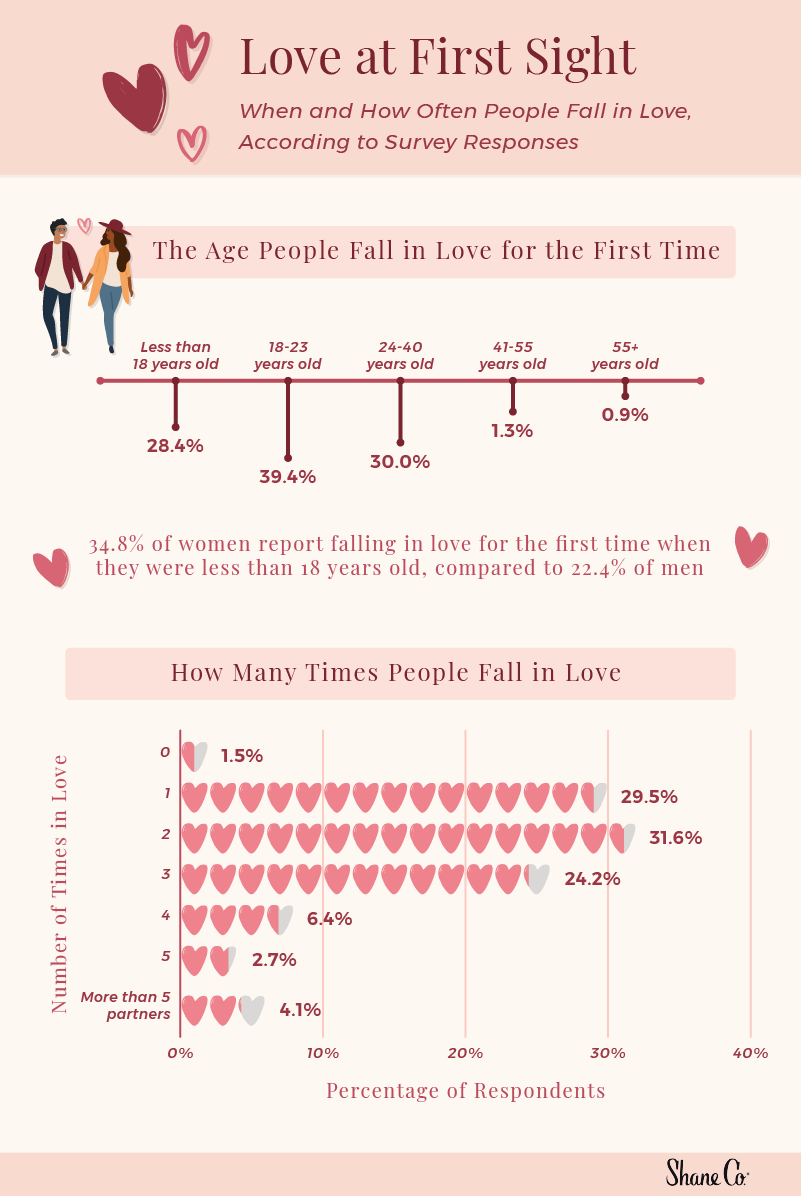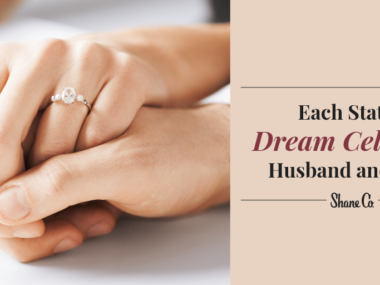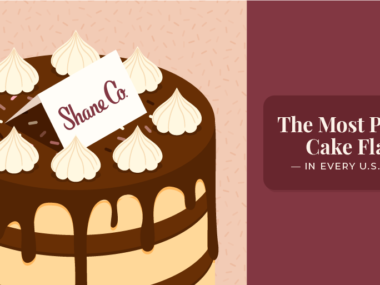
Love is a powerful feeling — there’s a reason there have been millions of songs, novels, and poems written about it. It’s also a mysterious feeling. It can make us do things we’d never expect. We’re in the business of love at Shane Co. and were curious to know more about love and its role in relationships, particularly the what, when, where, why, and how around saying “I love you.”
We surveyed 750 people across the U.S. about their experiences with love, everything from the age at which they first fell in love to whom they prefer to say “I love you” first in a relationship. Additionally, we surveyed an equal number of respondents from each U.S. state on the average amount of time it takes for them to say “I love you.” Read on to learn more about what we uncovered!
Love at First Sight
Before diving into state-by-state love timelines, we wanted to get a general idea of Americans’ attitudes toward love.
Most people say they’ve been in love before, with the late teens and early twenties being the time where most individuals experienced love for the first time (40%). More women report falling in love for the first time at a younger age, and a greater number of Baby Boomers and Gen Zers report falling in love at a young age than other generations.
Generally, most people have had a couple experiences being in love, with over half of respondents having been in love with two or more past partners.
But how long does it take to fall in love? For that, we went to the map. After all, from Verona to New York City, a great location is the key to every great love story.
When You Know, You Know: How Long It Takes People to Fall in Love
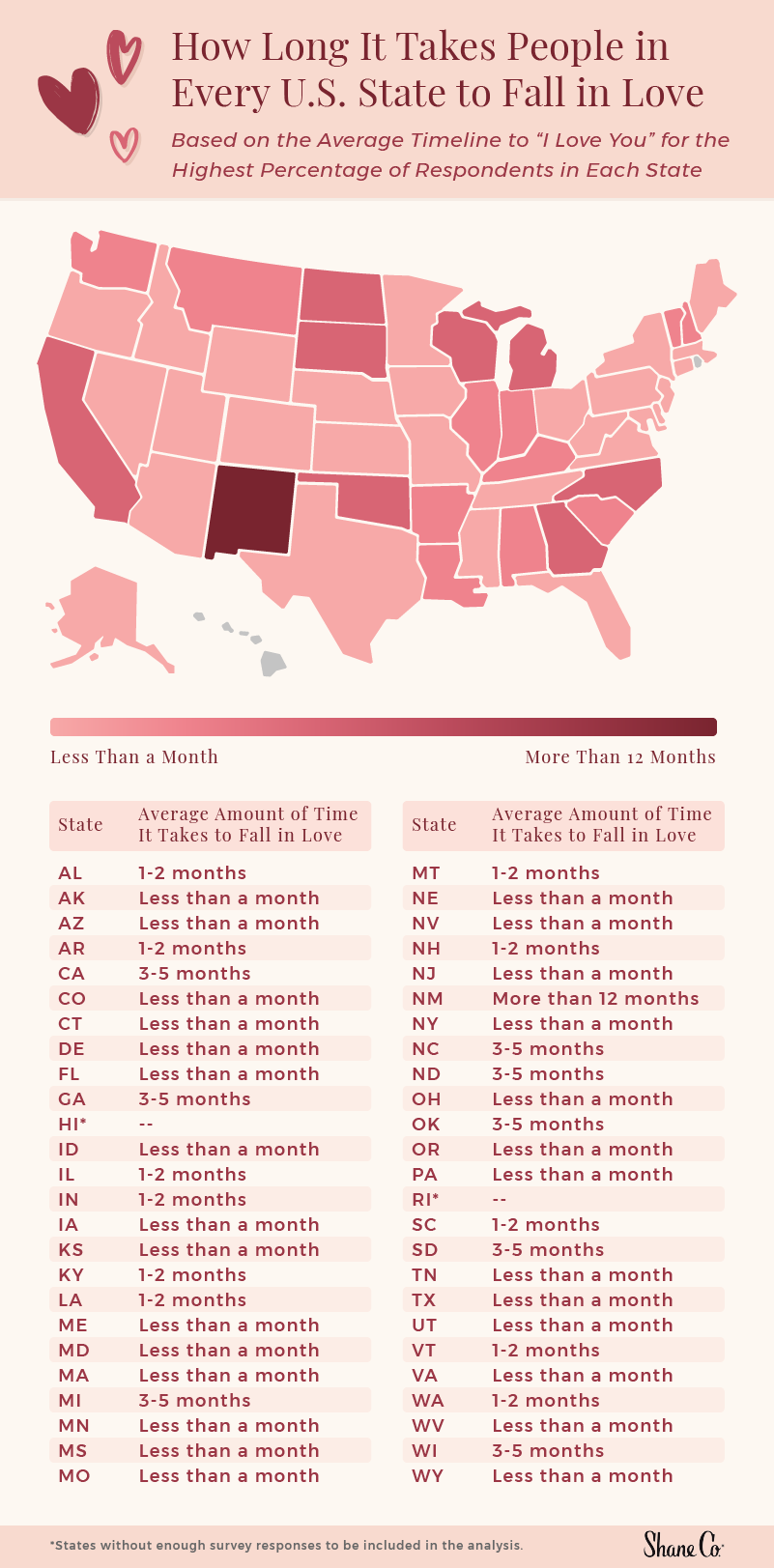
First, we looked at national responses for how long it takes individuals to fall in love.
Overall, it looks like Americans tend to fall in love pretty quickly. Over a quarter of respondents say that it takes them about 3-5 months to fall in love, and over half of the respondents say that they fall in love in five or fewer months. These timelines vary based on the age of the respondents. Comparing generations, the highest percentage of Gen Zers report falling in love with their most recent partner in less than a month — 1 in 5 Gen Zers.
How did the results measure up geographically? We found that generally, residents of the Northeast and Mid-Atlantic tend to fall in love pretty quickly. New York, Connecticut, and Delaware are all among states where at least 1 in 3 residents report falling in love in less than a month.
However, looking at our next map, we can see a huge geographic range of states where residents fall in love the fastest.
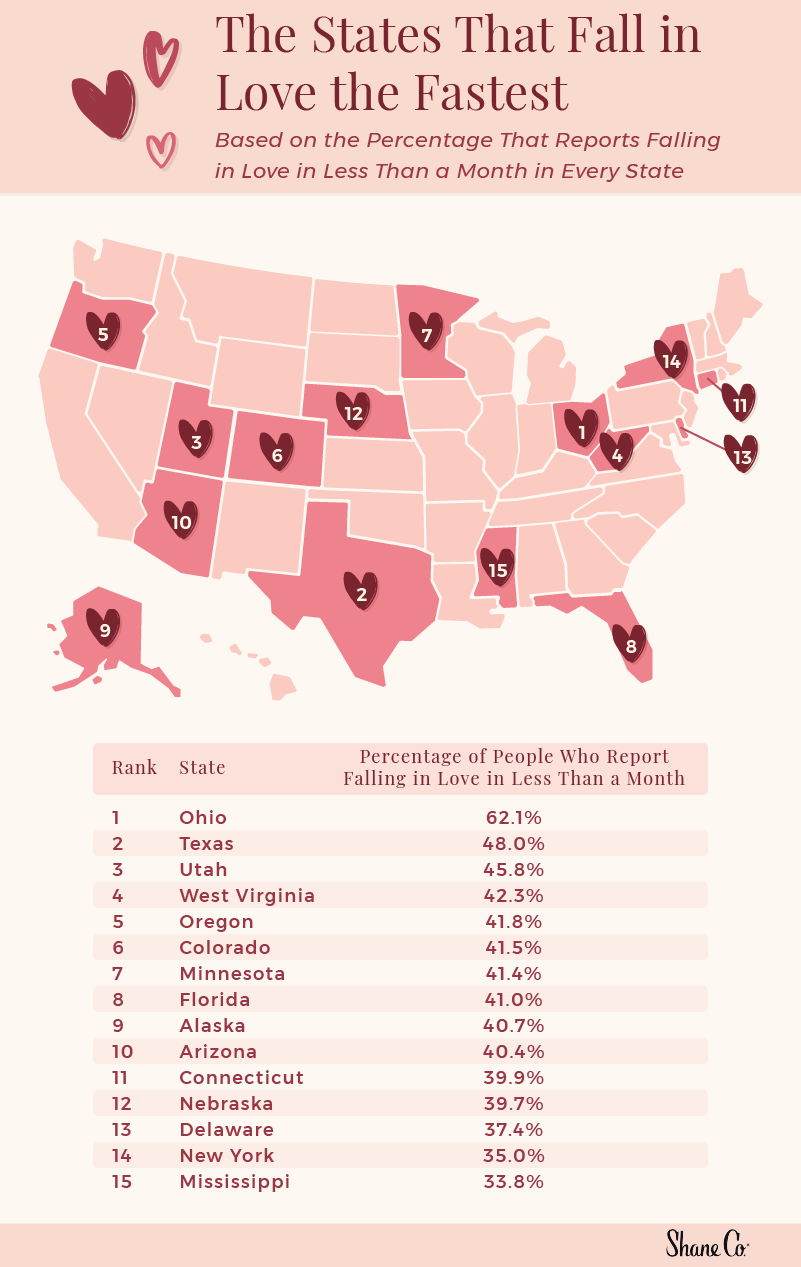
Based on the percentage of people who report falling in love in less than a month, Ohio is the state where romance develops most quickly. Over 60% of Ohio residents surveyed say they typically fall in love in less than a month. In case you’re wondering about the most romantic spots in Ohio, US News and World Report created an Ohio romantic getaway guide featuring different homey inns and some spots on Lake Erie.
We were surprised to find that many southern states, whose warm summer nights and open fields seem like ideal backdrops for whirlwind romances, were not among the states where residents fall in love the fastest.
Finally, we were impressed to see a cluster of states including Arizona, Colorado, and Utah all among the states where people fall in love the fastest. Since New Mexico is the only four-corner state not included in the top 15 states for the fastest romances, residents there may want to invest in an out-of-state romantic getaway for quick romance.
Who Should Say It First and When

Regardless of how quickly individuals fall in love, we know that sharing romantic feelings is an entirely different question. For instance, while the Midwest might be a hub of quickly developed love, their famously calm, reserved demeanors may keep residents from sharing their feelings. Therefore, we decided to ask about general attitudes toward sharing feelings and relationship timelines.
We found that attitudes toward sharing expressions of love are pretty limited. The highest percentage of respondents (37.8%) told their most recent partner they loved them a few days after realizing it, though 15.4% told them immediately after realizing it.
Gender did affect opinion on when to say “I love you.” Most respondents express that in the past, men have said “I love you” first, and, in fact, 65% of men do say they like to say “I love you” first. However, it’s worth noting that sometimes people do say “I love you” before they are ready.
Why People Might Say “I Love You” Before They’re Ready
We asked people about whether they’ve expressed love before they were ready, and were struck by how common that experience was. More men feel pressure by a partner to say “I love you” before they are ready than women — 61.9% vs. 46.9%, even though 65% of men like to be the first to say “I love you” in a relationship.
We also found that, demographically, a higher percentage of homosexual-identifying respondents feel pressured by a partner to say “I love you” before they were ready than heterosexual-identifying respondents — 69.6% (gay) & 63% (lesbian) vs. 48.8% (heterosexual). Furthermore, over half of all generations except for Baby Boomers have felt pressure from a partner to say “I love you” before they were ready.
What does this add up to? 1 in 2 respondents have said “I love you” to a partner but not really meant it, with higher percentages of bisexual and homosexual-identifying respondents than heterosexual-identifying respondents having said ”I love you” to a partner without meaning it.
This made us wonder: What about those individuals who haven’t been in love at all?

Based on geographic responses, we found that while there are some states where individuals fell in love very quickly, there are other states where many individuals have never been in love.
Half of the respondents surveyed from Montana have never been in love, and in the top 15 states listed, at least one in three respondents has never been in love.
Nationally, we found that more than half of respondents (53.6%) report mistaking love for lust, attachment, or obsession in a past relationship. And so, perhaps, even in the states where individuals fall in love the fastest, those respondents will grow to realize their feelings of love were only lust after all.
Final Thoughts
Whether you’ve been in love before or are still waiting to meet the one, one piece of advice we can offer is to make sure to tell your loved ones how you feel about them. In fact, 42.3% of survey respondents report feeling regret over not saying ”I love you” to a past partner, which can lead to a lifetime of wistful thinking over the one that got away.
And while you don’t necessarily need to give someone a gift to express how you feel, our selection of gifts is a great way to provide a reminder of how you feel about someone every day. Whether it’s a simple necklace or an engagement ring, our gift finder can help you select the perfect item for your special someone.
